#specifically a rhesus macaque
Explore tagged Tumblr posts
Text
Thinking about. Daemon AU. Thinking about Jimbei having some kind of amphibian (Chinese Giant Salamander?) and it having to try and drag Luffy's monkey daemon off Marineford while Jimbei carried Luffy.
Thinking about the daemons being too slow, and Jimbei having no choice but to pick Luffy's daemon up in order to get them out of there.
Jimbei is ashamed! He has compounded an already traumatic event for Luffy by trespassing against him in a way that can never be apologized or atoned for. He tries so so hard to stay distant and respectful when they meet again, and Luffy hasn't ever brought it up but he's also keeping physical distance so Jimbei assumes he has graciously been forgiven but also that Luffy doesn't feel comfortable putting his daemon in Jimbei's touching range, which does sting -- he would never have done so outside of such extenuating circumstances -- but he can't fault Luffy for his caution.
Then Jimbei gives Luffy a blood transfusion, and as they're both laying there Luffy's monkey crawls over and climbs right up onto Jimbei's chest to curl into a little ball over the scar he got saving them both. As the crowd of gathered fishfolk start absolutely losing their collective minds, Jimbei just goes "Ah. I see." And puts a comforting hand on the monkey's back.
#One Piece#Monkey D. Luffy#Jimbei#Jinbe#Jinbei#Fishdad please what the hell is your name#Daemon AU#I'm still debating what I actually want Jimbei's daemon to be#but I am a Luffy Monkey Truther or I'll die#specifically a rhesus macaque
23 notes
·
View notes
Text
Six Ears design
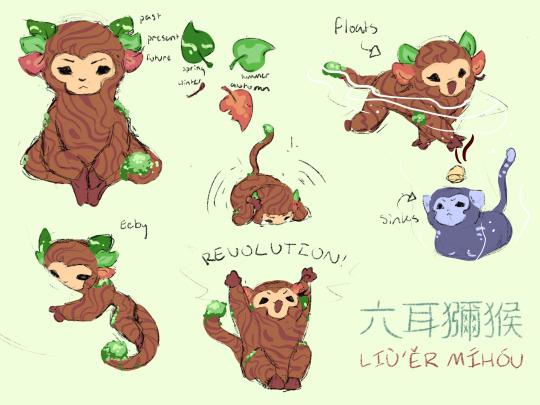
because I am once again not doing alright!!
Some of you may remember my Wukong design where I just mess around to draw a cute monkey, and I am back on my BS yet again! The voices will not shut up about these stupid monkeys!!
I was hoping to finish the entire roster of primates this weekend, but unfortunately life is not yet done slapping me in the face, so here is the one that’s been rotting my brain the most.
Design notes!
Because of we already have a stone monkey, I am keeping things on brand and making all of the primates elemental! Obviously, Míhóu is wood! (More on this when I finish the other two)
His ears are leaves that correlate with seasons! Is it summer? Past ear will be spring, and future ear will be winter, so on and so forth. Yes, they still function as intended, just able to photosynthesize as well.
Same as Shíhóu, I took references from baby langur monkeys and rhesus macaques. I think it makes sense that they’d be approximately the same species, considering the plot.
I couldn’t think of any clothes for him? I guess it makes sense for Wukong to be the only clothing-wearer, because he’s the only one that contacts society, but it still feels weird drawing him nakey.
Little patches of lichen litter his wood-fur in random places (wherever feels cutest), though most notably on his tail. I’m considering reworking it slightly so they specifically go on fluffy/differently coloured parts of actual monkey fur.
Considering the fact that the only proper description we have for Míhóu is when he looks identical to Wukong (and also his namesake) I’ve decided to just ignore trying to follow canon in that right. Makes things more fun.
And that’s all my notes! Really sad I can’t get to Yuanhou and Mahou quite yet (I have so many ideas for them) but I hope I can get to them soon!
Other than that, I’ve made some small refinements to my Shìhòu design—mainly his staff. It felt a bit too Monkie Kid for me. I’ve always wanted to really lean into the “he’s just hulking around a large pillar” idea, so I did some research on Chinese pillar designs and reworked it to resemble a huabiao! Something I’ll likely show when I put out my Gibbon and Baboon art.
And that’s all I got! Have this concept sketch from months ago while I head out to scream into the aether :3c
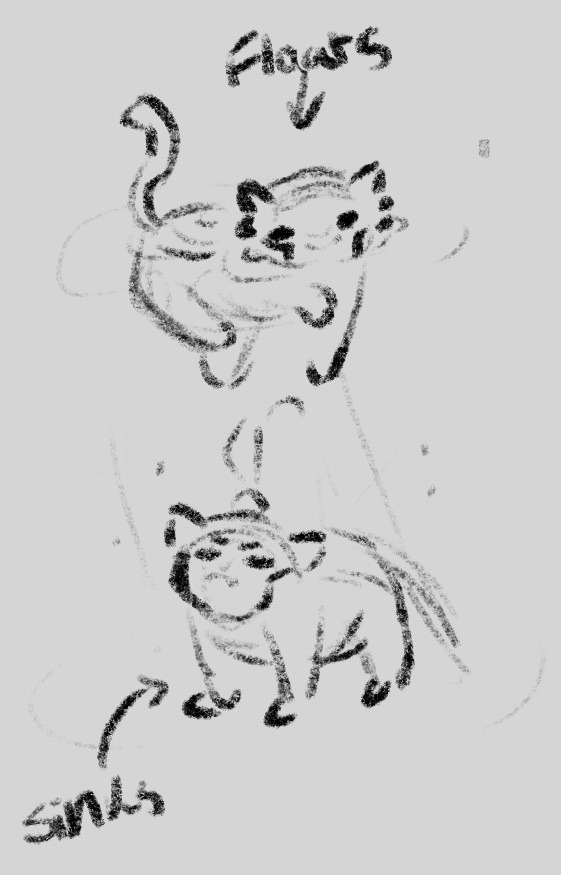
#journey to the west#jttw#xiyouji#six eared macaque#liu er mihou#lego monkie kid#monkie kid#lmk#tagging lmk cause i think the lego fans will also appreciate this#post!#art!#making mystic monkeys
217 notes
·
View notes
Text
Macaque study # S4 SPECIALS
Let's go with Macaque in the special of season 4! There will be a lot to say here too. The specials offer us a very interesting insight on what happened between Wukong and Macaque while also taking the first step towards their reconciliation.
The first appearance of Macaque in the specials is immediately centered around Wukong (and his conflict with him).
MK : We have to try! He'd do the same for any of us.

Macaque averting his eyes while MK says this very sentence is not coincidental. Obviously Macaque doesn't think Wukong would really do this if it was for him. After all, Macaque still has this image of Wukong he's fueling. The one of a selfish person who doesn't care. Yet Macaque still wants to go with MK. This time MK didn't even ask him to help, Macaque stepped up on his own. I think it's important to notice this because Macaque could have just chosen to not care. Contrary to season 3, nobody asked him to save the world, nobody asked him to help. Perhaps because they're not sure of his position in the matter.
Yet Macaque still chose to help on his own. It really shows how much he really cares about this even if he acts like he doesn't by being grumpy.
Within the first few minutes of Macaque being inside the scroll of memory, he already showcases a lot of familiarity with Wukong past self and Wukong in general :
- He instantly recognizes that the Wukong they see is a memory (perhaps because he knew Wukong at this state in his life?)
- He said that he can “smell him a mile away” which while very funny also portrays a sense of familiarity. I did some research on that and while old world apes like rhesus macaques don't have a strong sense of smell, they do use smell to differentiate between members of their social group. Macaque being used to Wukong smell can portray how Macaque was a part of Wukong social group back in the days.
- And finally the lil monkey they find immediately attach itself to Macaque rather than MK. It does really show how Macaque lived on the island with Wukong, and how contrary to any other members of the brotherhood, Macaque lived with the monkeys. He was part of the troop. And the monkeys probably missed him a lot too.
Those are rather oblivious details, but it does set the record for the rest of the specials. Macaque was very familiar with Wukong, probably more familiar than any other members of the brotherhood. He was part of the troop, he lived with Wukong. Wukong was his king.
I think it's also really fun how Macaque tells MK to read JTTW. When they come across Wukong training under Subodhi, Macaque specifically tells how this scene is in chapter 1. That means Macaque himself have read the book. Maybe, after being resurrected, Macaque got curious about the journey and decided to read the book, or he just wanted to know what happened to Wukong after his death.
After this, they both stumble upon a very important scene : Macaque under the tree on the beach and Wukong coming to him.
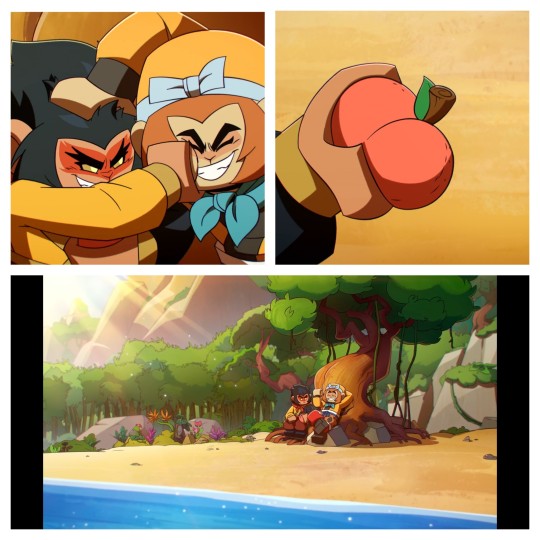
There is a lot to say in this scene.
Wukong : Macaque, you're okay bud?
Macaque : Welcome back your majesty
Wukong : ah, don't be like that. Eat some fruits, suck up the sun. That's why I've been training so hard.
Macaque : What? So you can be the strongest?
Wukong : Nooo well maybe a lil bit. But that's not the point! It's so we don't have to worry about anything or anyone ever again. Just live a lazy life sitting in the sun, eating fruits. And doing whatever we want. Sounds pretty good? Huh? Huh?
So with nothing but the dialogue we already got the key points of Wukong's motivation, his fatal flaw that led to his downfall and the basics of his relationship with Macaque.
First, Wukong is mainly driven by the need to protect others. The first thing he tells Macaque when he sees him is “Are you okay?”. And while at first we can assume Wukong is simply overprotective, we also see Macaque bandaging himself before Wukong comes to him. That does show that whatever threat Wukong was desperate to protect Macaque from (poachers, demons) it does exist. Flower Fruit Mountain, while being a rather difficult place to reach and thus quite protected, is not completely safe. Macaque can still get hurt.
Second, Macaque is sarcastic when he says “your majesty”, that does showcase that while Wukong is a king, Macaque doesn't treat him as one. He treats Wukong as a friend. That's why he uses this title so lightly. Macaque's light jab “welcome back” is also most likely an allusion to Wukong's frequent escapades to become stronger. Clearly, Macaque is annoyed by Wukong's absence. Maybe he feels like a servant of some sort, waiting for Wukong to return.
What I find interesting is that we can see here how Macaque is much more comfortable with Wukong alone than with the brotherhood. Here, Macaque is not afraid to express his dissatisfaction with light sarcasm. Whereas, in the brotherhood, when Peng was mocking him, he didn't reply at all and kept quiet.
Third, Wukong's flaw shone through the interaction despite his main drive (which is to protect). Macaque is aware of Wukong's flaw when he replies “What so you can be the strongest?”, and even Wukong recognizes his thirst for power. This is really important because it's a key point to understanding their downfall. While Wukong's intentions were originally good, he let his desire for powers and glory blind him. At this point in time, his desire still doesn't take precedent over his dream. But the more he'll gather power, the more he'll lose sight of why he started this quest of strength for. The more he'll lose sight of Macaque. The more he'll keep feeding this desire with Azure's recognition.
And like the scene of the brotherhood banquet, Macaque is reassured when Wukong mentions their dream again, more likely comforted by the fact Wukong didn't forget their common dream. Truly, even at the earliest stage of their friendship, Macaque already had the fear of being forgotten .
[ Apparté : I think it's sweet how we sees Wukong idea of a paradise : he needs “sun”, “fruits”, “safety” (proof in his words : “we don't have to worry about anything or anyone ever again”) , “liberty” (“And doing whatever we want “) and “Macaque” (emphasis on the “we” He repeats constantly).]
Macaque: quit it, eat your dang peach
Wukong : you're a peach.
Lastly, this scene introduces us to the peach symbolism in Macaque and Wukong relationship.
We know how obsessed Wukong is with peaches, so for him to give one to Macaque is already a physical proof of his care. He even goes as far as to call him a “peach”. It might be subtle, but truly this is a great show of fondness and care coming from Wukong. Here we have two shows of affections coming from Wukong : gift-giving and endearments, all related to peaches because that's what he likes the most and thus is the ultimate show of his affection.
The peach represents their friendship. It also, in a metaphorical lense, represents longevity. As such, it can represent Wukong's desire for Macaque to be safe and to live a long life. Macaque accepting the peach is, of course, him accepting Wukong's show of care but also accepting his protection/ the longevity he gives him.
The act of gifting a peach is also metaphorically a wish for love, happiness and well-being. And I think this encompasses Wukong’s feelings perfectly. He wants Macaque to be well and happy. He wants to protect him and cares for him. And Macaque accepts this show of affection coming from Wukong.
After this particularly sweet scene, we get the scene of their downfall: the fight under the mountain.
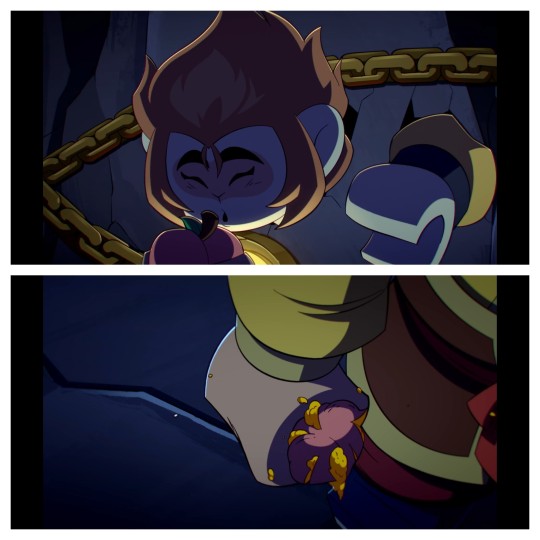
Macaque : Hey bud, I got a lil something
Wukong : What for me? You're not serious, that whole peach is for me? Oh bud, you shouldn't have!
Macaque : Okay, you don't have to be so you about it.
Wukong : no, no honestly this is exactly what I need right now. I'm trapped under the mountain but the Six-eared Macaque brought me a peach. Hooray.
Macaque : You know I'd help if I could.
Wukong : Oh sure, cause normally you just rush to my rescue.
Macaque : yeah, okay.
So with this first section of the dialogue we learns a lot already.
First, Macaque coming to hand a peach to Wukong is, of course, made to comfort him in his rough situation (peaches are probably his comfort food) but it’s also an offer of friendship. Macaque is offering his company. His friendship. Because, truly, he cannot offer anything else.
But Wukong's response is a very cutting antiphrasis, sarcasm in short. Very much like Macaque in the previous scene, he uses sarcasm to convey his frustrations and feelings. But it hurts way more here. Because Wukong is not only refusing the peach, he's also refusing Macaque company and friendship. He uses Macaque full title to create distance between them.
We can translate Wukong's antiphrasis like this :
- What for me? You're not serious, that whole peach is for me? Oh bud, you shouldn't have!
- I don't care about the peach. It's not what you should do!
- no, no honestly this is exactly what I need right now. I'm trapped under the mountain but the Six-eared Macaque brought me a peach. Hooray.
- I don't need the peach right now. I want freedom. You're the Six-eared Macaque and the only thing you can offer me is a peach? Why can't you free me? (I translated it like this because of the use of Macaque's full title. Here, for me, Wukong is mocking Macaque inabilities by saying his full title, full title being generally a show of power.)
What Wukong wants is freedom, more than friendship, more than company, more than comfort.
Macaque tried to convey his helplessness by saying that it's not like he doesn't want to help, it's that he cannot, he doesn't have the capacities to. But Wukong doubts Macaque's willingness to help with sarcasm once again.
- Oh sure, cause normally you just rush to my rescue!
- You never rescue me. You never help me.
Like we previously see, Macaque prefers to avoid conflicts rather than face them. When he sees Wukong unwillingness to listen, he rises and walks away. I think Macaque's position was really telling in this scene. He sat beside Wukong. Not in front of him. He lowered himself on the ground, maybe to lower himself to Wukong's level and not look down on him in a show of companionship, and sat at his side in an act of silent support. But when Wukong rejects that companionship (rejects Macaque), Macaque rises and walks away. He doesn't crush the peach yet but simply takes it away. Thus, it shows that their friendship has not been crushed yet. Macaque takes Wukong's rejection in stride and decides to take back his offer of friendship at the moment.
Wukong : Well it was great seeing you bud, just run off like you always do.
Macaque : No, that's you! You're the one who's always running off, looking for more powers, for more sources of immortality. You're one who wouldn't quit while we were ahead. Not the great sage, he's gonna drag everyone else into his mess.
Wukong : you're not in this mess, you're still free ! Everything I did was for us!
Macaque : You did it for yourself. You've become like this… obsessive demon. I told you going against the Jade Emperor was a bad idea, but no, Wukong doesn't listen to anyone. He just does whatever he wants. You put yourself there, not me.
Wukong : Fine! Leave! I don't wanna see your face here again you big- hugh. I really wanted that peach.
And that's the words that makes Macaque explode.
Wukong is definitely salty about something here, he mentions how Macaque always run-off, perhaps that's because he felt like Macaque abandoned him after his defeat against the Jade Emperor. Macaque most likely escaped with the brotherhood via a portal, it would explain how they were be able to avoid the heavenly soldiers after Wukong’s defeat. Wukong most likely felt like he was left behind, tossed away the moment he lost, and resented Macaque for this.
Macaque on his part is furious because he felt like he was the one who had been abandoned. It's not Wukong who has been abandoned. It's him. He emphasizes this feeling by reminding Wukong of his numerous escapades and repeating the verb “running off” that Wukong used, trying to show Wukong that he's not the one being abandoned, it was Macaque all along. This is probably a boiling feeling who festered for a long time and exploded here. He also emphasizes Wukong's flaw by mentioning power and immortality. Essentially Macaque is calling out Wukong on his flaws, saying that he forsake their common dream for strength and longevity. He uses the title “Great sage” as an insult, probably to mock Wukong's desire for grandeur, and also put the blame entirely on Wukong, saying that he's the one who dragged “everyone else” (Macaque, monkeys and the brotherhood) into this situation. Which is largely untrue. This situation was the result of a lot of additional factors. But pushed by his emotions and his festered frustrations, Macaque is blind to this.
Wukong replies to this by saying that Macaque is not in this mess. Ignoring Macaque's own pain and wounds after the battle and only focusing on himself. Which we cannot truly fault him for. He's cut off from the rest of the world, being tortured daily, he probably thinks that the brotherhood and Macaque have great lives. But still, he's ignoring Macaque's pain. He also emphasizes how “everything he did was for us” ( in my opinion it’s a very romantic line, he doesn't say “everything I did was for everyone!” which would include the brotherhood and the monkeys, he uses “us”, which only includes Macaque and him.). I think at a certain point Wukong blinded himself, convincing himself that each of his choices were driven by his common dream with Macaque, when in truth, at the end, most were driven by his own selfish desires.
Macaque calls him out on this. It's interesting to see how Wukong is particularly angered by the moniker “obsessive demon”, probably because by calling him a demon (in JTTW, the representation of strides and enmity) Macaque put him on the same level as all the demons that came on FFM, the enemies Wukong was desperate to protect Macaque from. Macaque also emphasizes on Wukong's selfishness and how he never listened, again festering frustrations that comes in the surface here. In the end, he says Wukong puts himself in this situation, which is true. Wukong had the choice to stop this mad quest at any moment (as MK said in the previous scene, he was already strong enough) but he refused to. Ultimately, his demise and emprisonnement under the mountain is due to nothing but himself.
Yet Wukong wants someone to put the blame on, probably to vent his frustrations and anger, and in this moment he chose Macaque.
Macaque crushes the peach after this and throws it away. A metaphorical ending of his friendship with Wukong.
Yet, after Macaque leaves, Wukong does say he “wanted that peach”. While, yes, story wise Wukong must be quite starved at this moment. It could also be a show of post-fight clarity where he truly admits that he, in fact, wanted Macaque’s companionship.
I don't think one of them is more right than the other in this scene. They're both hurting, and they both had faults. Macaque never stepped up until it was too late and let his frustrations fester inside of him. And Wukong was blinded by his desires and is, now, venting everything on the only person he can, and paradoxically the only person who cared enough to come see him, Macaque.
Ultimately, they both felt abandoned by the other in one way or another.
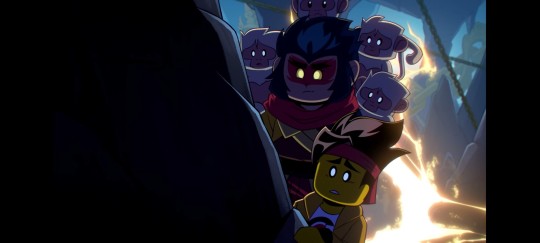
MK : So Monkey King really was the bad guy?
Macaque : That's what I believed, what Azure would have you believe.
That's a really interesting bit, because Macaque uses past tense. He admits that the image of Wukong he has been fueling, of him being the bad guy, is not necessarily true, and puts himself, or his past self, on the same level as Azure which is the season’s villain.
Then Macaque mentions the pilgrims and how they changed Wukong, taking him to a different path, but when MK mentions that this path was the path of “good guys”, Macaque answer with this :
Macaque : every choice has consequences, for someone.
First, while admitting that Wukong is not necessarily a bad guy, Macaque also doesn't admit that he's a good guy.
Second, this is a hint to what happened between them. We know they had another fight after the one under the mountain. One when Wukong was on his pilgrimage. Macaque talks about consequences. We can speculate that the “someone” he mentions while talking about consequences is himself. Thus, maybe, he's saying that by choosing the path of the pilgrims, Wukong forsake Macaque in a way we don't know yet.
We have different hypotheses we can make as to what truly happened and the reason they fought. I personally have three different hypotheses :
First, like on JTTW, Macaque attacked the pilgrims (maybe to “save” Wukong from the circlet). Even if he's the one who ended their friendship by walking away from the mountain and crushing the peach, it's still difficult to sever all links with someone who has been such a great presence and source of happiness in your life. Macaque could have easily heard Wukong's suffering.
Second (very similarly to the first hypothesis) maybe Macaque attacked the pilgrims but this time in a bout of jealousy. He saw how the pilgrims were able to change Wukong while he couldn't and felt replaced.
Third, maybe Macaque didn't attack the pilgrims. Maybe after he severed his friendship with Wukong he felt lost and spiraled out of control. Going on in the path of destruction. And Wukong, as a pilgrim, was sent to stop him. Cue the fight and Macaque's inevitable death.
Before season 5, I was more tempted to believe that my first two hypotheses were more likely due to their likeness with JTTW. But after season 5, I'm actually leaning on the third. During the short extract we have of their fight, Macaque sounds particularly unhinged, further proving that maybe he was really out of control at the time. Furthermore, after the ending of season 5, Macaque is more or less linked to chaos.
In this scene Macaque says : “Wukong was on a path of self-destruction, we all were.”, what's important here is that Macaque puts himself (and the brotherhood) on this path of self-destruction. He also emphasizes how the pilgrims, in particular the monk, was the reason Wukong deviated from this path.
But contrary to Wukong, Macaque had no-one to help him deviate from this path. It's not far-fetched to think Macaque spiraled out of control after the loss of his friendship with Wukong, going further in the path of self-destruction, until chaos engulfed him. And then Wukong was sent to fight him, to stop him.
Anyway, let's leave the hypotheses aside and go back to the study.
I think it's kinda hilarious that Macaque truly does sniff Wukong out, 😂.
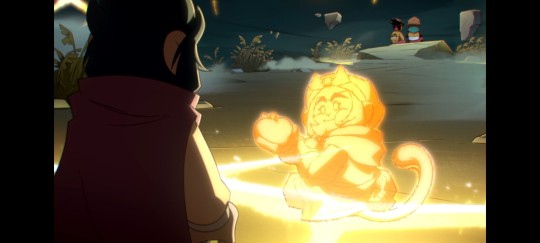
After this, they find Wukong before a cliff with fragments of memories. Wukong admits that he blinded himself with his desire, saying “I just wanted to protect the people I cared about.” with this particular shot, of him handing a peach to Macaque, does emphasize that Macaque is part of the people Wukong cares about. Again, here we have the peach gifting as a symbol of their friendship. And what is even more important is that Macaque steps forward and reaches for the peach before his past self comes along to take it and sit beside Wukong. It shows how Macaque still cares for this friendship with Wukong, he still wants it.
Then, as Macaque gazes at his past self with past Wukong, he reaches for them before letting his hand fall down.
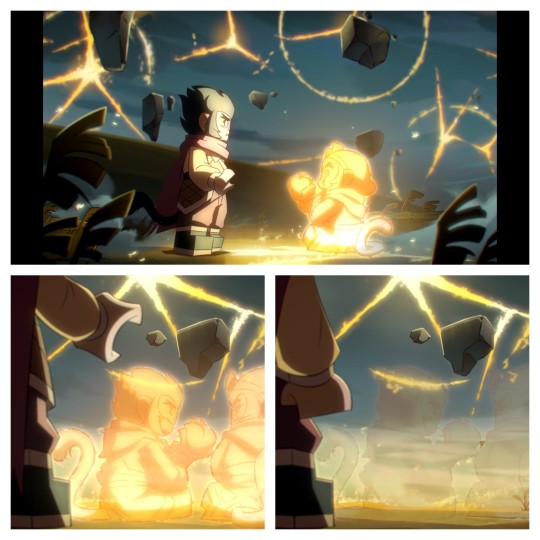
Really, it does show Macaque still yearns for this friendship, but ultimately he gives up. Maybe because of all the bad-blood between them, or maybe because he doesn't feel ready for this yet. No matter, this shows that Macaque doesn't just have hatred towards Wukong. He already admitted that his image of Wukong wasn't entirely true, and then here he shows traces of yearning. In any bruised relationship, the first ever step towards healing is the wants to heal, the wants to even have a relationship, and here Macaque showcases it.
I think it's important that the moment MK begins to talk about “fixing”, Macaque comes and Wukong gazes at him. Maybe it's a sign that Wukong also wants to fix whatever is between them.
MK : I need you to be the Monkey King.
The first thing Wukong does after MK says this is to look at Macaque. And it's only after Macaque smiles at him that Wukong nods and rises. It's very lil, but it's a sign of acceptance on Macaque's side, and a show of care on Wukong's. If Wukong truly didn't care about Macaque anymore he wouldn't search for his acceptance like that. Moreover, Wukong is silently asking Macaque if it's okay to be the Monkey King, to be the hero, to be what essentially killed Macaque, and Macaque smiles and encourages him to be this hero. On Macaque's part, this is a huge step forward. He hates Wukong as a hero because, for him and for a long time, he believed it was what led to their downfall. But here, he encourages Wukong to be one.
The Macaque from season 2 who did a whole shadowplay on how awful heroes are would never do this.
This is really a huge character development for Macaque. It does show how his view of Wukong is changing and how, progressively, he's letting go of his assumptions and hatred, of the fake images he created of Wukong.
After this, we get another flashback of the brotherhood. And if we didn't understand how much Macaque didn't fit with this group before, it's even more obvious now.
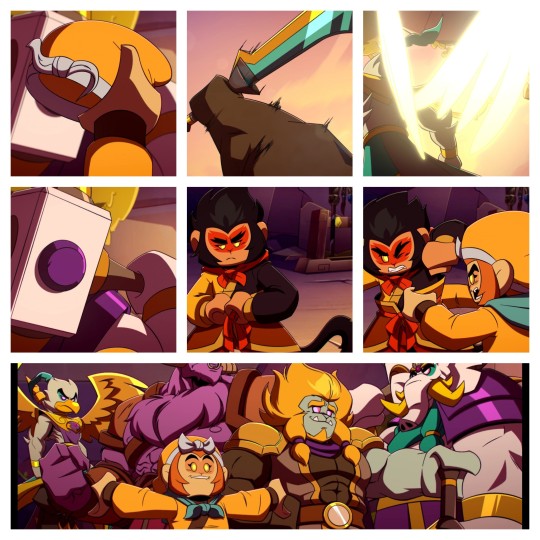
In this scene, all the members of the brotherhood are preparing to fight, there are beautiful and dramatic shots of their clothes and weapons to emphasizes this. All shots are very dynamic. And then we have all the brotherhood standing together looking forward (except Azure who's instead looking at Wukong, probably to showcase how his admiration for Wukong blinded him and made him lose sight of his goal).
Except Macaque isn't in the shot. And the only one who bothers to go to Macaque is Wukong.
Moreover, Macaque clothing shot is static, he looks annoyed, and it's not as dramatic nor as powerful as the others, he's also standing in the back. Frankly he looks like he's dressing himself to go do the groceries. Really, it's a sign that Macaque isn't on the same wavelength, he's not willing to do this, his only link to the others is Wukong who comes to him to help him dress.
All the others are more or less after glory, they act like they're on a grand quest, except Macaque. And even if we don’t get a shot of Bull King clothing himself, he's still standing on the very epic shot of all the members of the brotherhood looking in the distance.
There is a clear dichotomy between Macaque and the others. The others are all depicted in a very epic light, while Macaque is more or less normal.
After this we get back to the present, with the entire team and Nezha in Wukong's shack, while Wukong is explaining their plan. Everyone is here except Macaque. Macaque appears in the shack with a shadow portal. It demonstrates that once again Macaque is helping out of his own volition. Nobody asked him or dragged him in the shack, he went there himself to participate. He could have left after rescuing Wukong, nobody expected him to stay and help considering they didn't drag him with them, but still he decided to stay and actively went into the shack to hear the plan and participate.
But because he's Macaque, he does throw a light insult at Wukong by calling him out on his smell.
After a light training, the fight against the brotherhood begins, and Macaque is put against Peng with Mei.
Peng : I don't know how you stomach it brother, the Six-eared Macaque fighting side by side with his own replacements. Is there anything Wukong could do that would break his hold over you?
First, Peng is tapping into Macaque's insecurities (of him being left behind by Wukong, of him being replaced) while also acknowledging how much obsessed Macaque is with Wukong. Until now, those facts were more or less known to us after observing Macaque, but here another character admits the same thing. That does mean that Macaque’s insecurities, fear and fondness/obsession towards Wukong are canonically noticeable by those who know him.
I love how Macaque answers Peng :
Macaque : You know what, Peng ? Straight up, I've never liked you.
Contrary to the past where Macaque avoided conflicts and prefered to keep silent and not answer Peng's quip, here, he answers, he bites back. Macaque is not the same anymore, he's not as docile, nor as afraid of conflicts. After being killed and resurrected, and fighting Wukong to death multiple times while arguing constantly, he's not afraid of fights anymore. He grew up. He changed from how he was. His experiences forged him.
After Azure's defeat, Peng tries to flee.
Macaque : Mei, let them go. After all, he always was the most cowardly of the bunch.
Oh, how do he turn tables on Peng!!! Macaque using “coward”as an insult when it was what Peng always called Macaque in the past is obviously the greatest roast ever, but it's also a tailored quip made to anger Peng and make him act rash.
We can see Macaque turning around while throwing a fanged smile at Peng, something we haven't seen in a while since season 3.
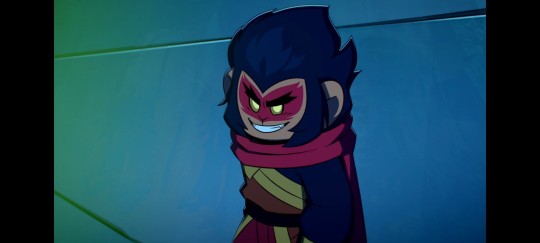
Those shows that Macaque is laying a trap here
The smile is made to provoke Peng, as is the quip. Peng falls for it and rushes towards Macaque, he's then face to face with Macaque kaiju form and Mei's dragon and decides to flee.
Speaking of fanged smiles. The lack of it this season is truly a sign of Macaque comfortability with the group. He doesn't need to pretend anymore.
After that, Macaque participates in the spell used to contain Azure and we get a very confusing short scene of Wukong passing on his cloud next to Macaque, rushing towards Azure to stop him, and Macaque looking at him in slow motion.
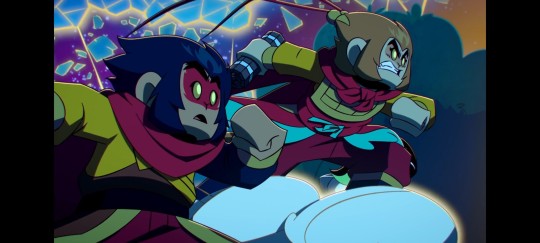
For this, I have no other interpretations but a really romantic coded one. I don't know why there is an emphasis on Macaque looking at Wukong for a second, the scene being in slow motion, except if it's for showing how Macaque's attention is always grabbed by Wukong, even when the threat is ahead. Macaque should look at Azure going on a rampage and focusing on the spell, yet when Wukong passes by him he can't help but look at him. You can have different interpretations for this, of course.
After Azure's defeat, the whole team decided to do a beach party. And Macaque invites himself, of course.
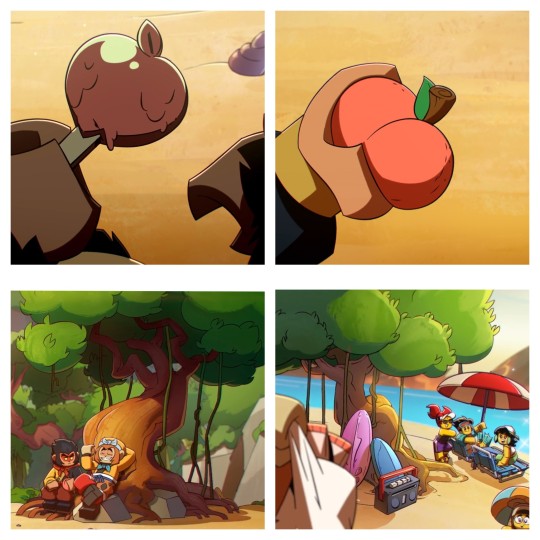
Wukong : yo, kinda blocking out the sun there. Oh it's you.
Macaque : Cute. Thanks for the invite by the way.
Wukong : And thanks for showing up even though you were not invited.
So, first, even though Macaque proved he's definitely not in the bad guy team this season, and even though we saw traces of yearning in both of them, they're still throwing quips at each other. Bad habits break hard. They both are so used to fighting, they probably don't know how to act when they're not. Moreover, all the bad-blood is not entirely gone, they still have quite the troublesome past on their shoulders with untold feelings and festering frustrations.
Second, the tree they're under is the same we saw in the flashbacks, a symbol of their past friendship. Clearly meant here as a sigh of their slow healing process, and the healing of their friendship. Wukong also gives Macaque a peach popsicle, not a coincidence considering peaches are another symbol of their friendship. This could be considered as an olive branch in itself but also as a quiet offer of rekindling, an offer to move forward.
Macaque : You know this is the calm before the storm, right?
Wukong : I know. But that can be a tomorrow problem. Whatever they're scheming, we can handle it.
Wukong furthermore emphasizes this by insisting on the “we”, including Macaque in the good guys team.
Also, Macaque calling Wukong cute? 🤨
But even though in this season Macaque willingly went around to help and defeat the villain, he's still not fully on the good guy team. Once Azure is defeated we can see him stand aside, there is a physical distance between him and the rest that would be furthermore emphasized in season five. I think it's important to notice this because it makes Macaque’s redemption arc more genuine. All his past faults are not magically forgiven, nor does he become buddy-buddy with everyone the moment he turns out good. His redemption is slow. The relationships he forged with the others are tentative at best. Even his healing friendship with Wukong is at its earliest stages.
In this season, we got a clearer view of Macaque as a character and how much he changed compared to his past self, but also how much he's willing to help, how much he truly cares.
Alright, that's it for Macaque in the season 4 specials. I'll do a final post for season 5 and that would be the end of this study.
Like always, if you have any other interpretations it's fine and you can share them, I'm curious about them.
Study S1 / Previous / Next
34 notes
·
View notes
Note
When you did your version of wukong did you have a specific species of monkey in mind to base him of? Or was him a mix of some monkeys?
It got me curious when you said you know a lot of monkey facts and I wondered if you used this to concept him?
EEEEEEEEE! You have no idea how excited I got when I woke up and saw this ask! I literally don't even care that it's the newest one I'm answering rn!
And also! Before I get into how I made the design for ITTW Sun Wukong, something I wanted to throw out is that a few people have asked for me to give more monkey facts after I foolishly /j divulged that I am an encyclopedia of monkeys, so I've been thinking of doing like a Monkey Facts Monday cause alliteration where I post a bunch of monkey facts on mondays! So lemme know what you guys think of that idea cause I absolutely am willing to do it! :D
Now ONTO THE MONKIE MAN!
In Journey to the West, Sun Wukong is described to be that of demon Rhesus Macaque.
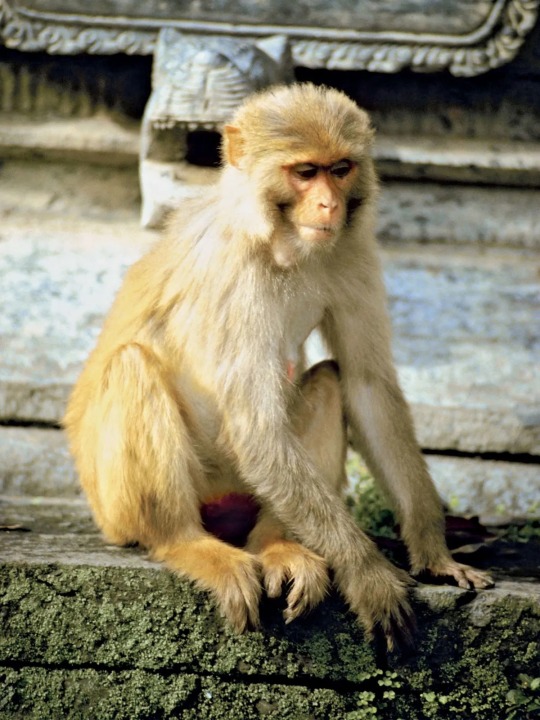
Rhesus Macaques can come in a variety of browns, greys, whites, and blondes, but for the most part are largely this stunning platinum gold color like in the picture above. I personally love this this color and wish we could see more golden furred Monkey Kings instead of just monkey=brown.
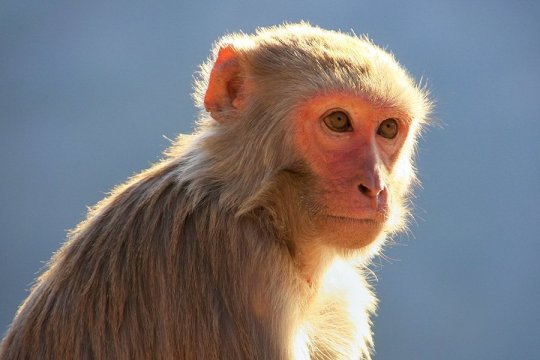
In addition to golden furs, a Rhesus Macaque's skin is largely a pinkish-peachy color with darker, nearly black, fingers and feet (You can see this in the first picture as well :)). And males tend to have more redish saturation around their eyes. (The saturation of this "mask" on males has been linked to levels of testosterone and therefore the dark/more red the mask the more potent the male, meaning it may be a sexual selective male trait as females have been observed preferring males with redder masks.... *looks at LMK Macaque simps*)
However, one thing about Rhesus Macaques is that they have very short tails. (As depicted below)
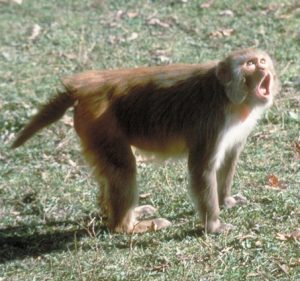
And that just wasn't quite the look a was going for. So while I was thinking "Eeeeh I could just say that he's a Rhesus Macaque with a long tail" but as I was sifting through my monkey knowledge I remembered another macaque species!
The Crab-Eating Macaque! Aka the Long Tailed Macaque!
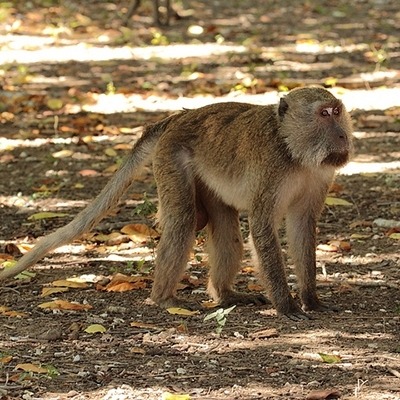
These macaques very closely resemble Rhesus Macaques in facial features as well as fur as they also come in a variety of gingers, browns, greys, and blondes with their main color variation being this brownish-gold. (below) Tho their pelts tend to range darker than a Rhesus Macaque's.
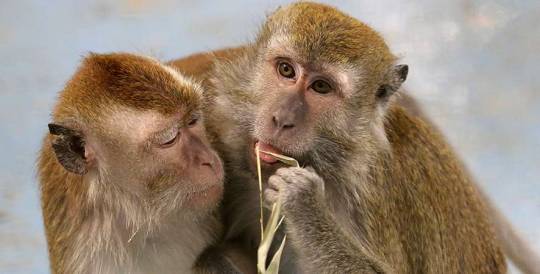
And instead of having mainly peachy skin with a few black tones around the hand and feet, they largely have very dark skin with the brightest parts being around the eyes and the darkest being their pitch black ears, hands, and feet.
And come on, you can't tell me this isn't a Monkey King face:
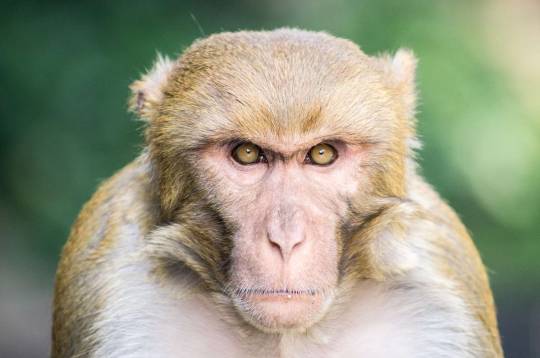
Plus I might be just a liiiittle biased because my favorite monkey picture is a Long Tailed Macaque:
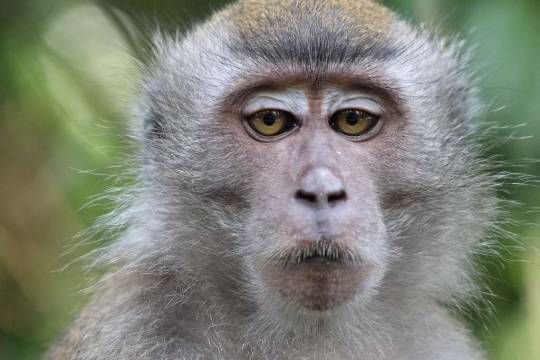
Just look at this dude! He's so done with life! 😂
But along with just physical characteristics, Rhesus Macaques and Long Tailed Macaques share many behavioral qualities as well.
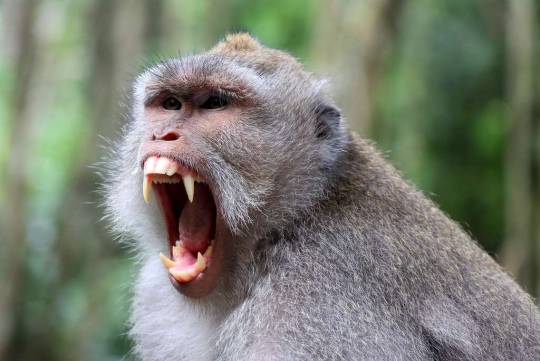
They both display threats in similar ways, such as baring teeth paired with screaming to frighten predators and other monkeys. Though, Rhesus Macaques tend to be more aggressive and bold (accurate to Wukong) while Crab-Eating Macaques are very cautious and skittish. A Rhesus would much rather fight while a Long Tailed would much rather run.
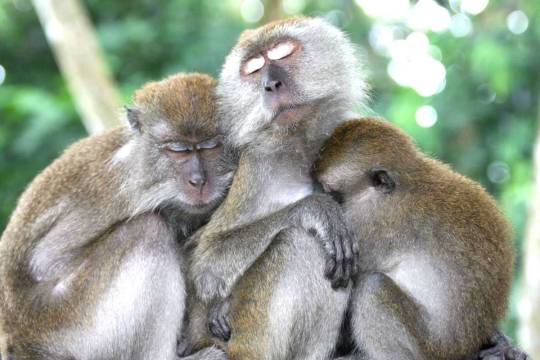
Another thing they share is their open affection for each other. Both Rhesus and Crab-Eating Macaques have extremely tight knit bond within their troop and with even form best friends from a very young age. Just look at this family unit and how the younger two hold the elder monkey! So sweet. 🥹
All in all! In the end, I went with a mixture of these two species for my ITTW Wukong design, leaning slightly more toward his original species, the Rhesus Macaque, and gave him the proportions of a human since he's a monkey demon.
The traits that I took from the Rhesus Macaques were his blonde fur and peachy pale skin tone as well as his more saturated peach mask, which I blended with a darker blackish-red at the bottoms to pay homage to the Crab-Eating Macaque's darker faces.
The traits that I took from the Crab-Eating Macaques were their long tails and black tipped ears. (as well as the blended mask)
And the traits I took from both were the black tipped hands and feet as well as their long fangs.
While his eye come straight from the book.
And this was the result!
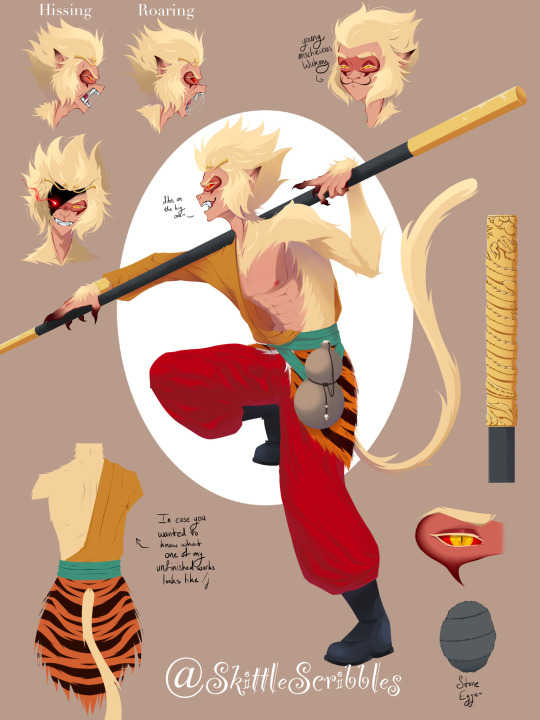
#skittle answers#my art#isekai'd to the west#ittw#ittw sun wukong#journey to the west#jttw#jttw sun wukong#jttw sun wukong fanart#jttw wukong#jttw monkey king#sun wukong#wukong#monkey king#original monkey king design#original sun wukong design
343 notes
·
View notes
Text
I think SWK is monkey pretty (obviously) and literally Uncanny Valley pretty like— he looks like a monkey but he's not, he just looks and acts and plays like a monkey, but he ISN'T. He walks a shaky line between Yaoguai and celestials too. and I've always seen him w human features sometimes.
I know the book says explicitly that he does look like that. A primate and that he's also short as fuck. But I think him sitting between monkey/ape/gibbon/macaque (or a mix of all four), Yaoguai, Celestial body, and human seems right with me.
For example, the Blackmyth WuKong's design:
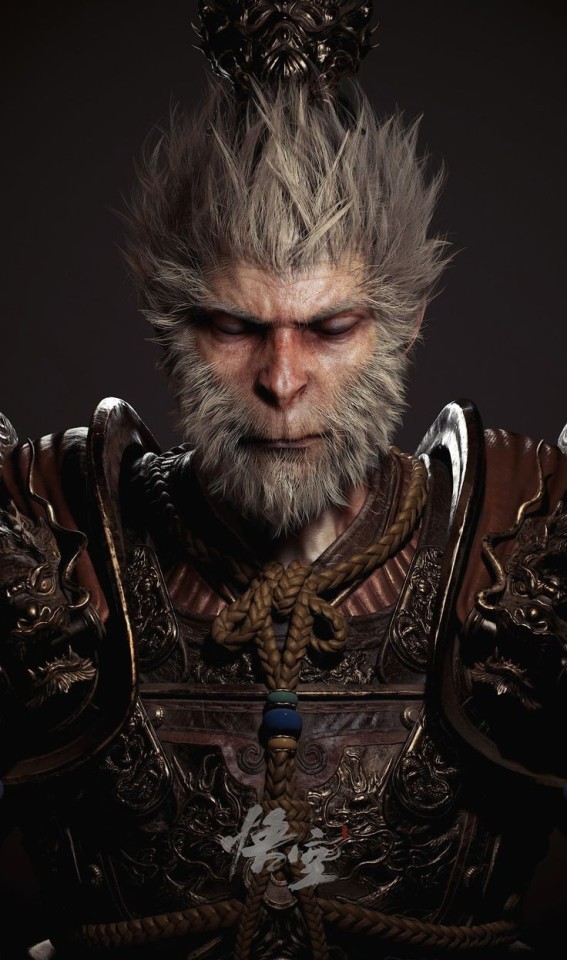
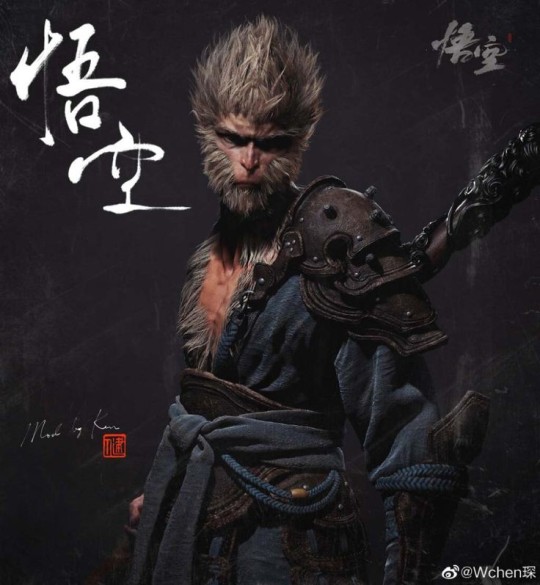
IT SITS JUST RIGHT. He's more human-like in his features but??? It's also very clear that he's a simian. The Monkey King Hero Is Back is like this too.
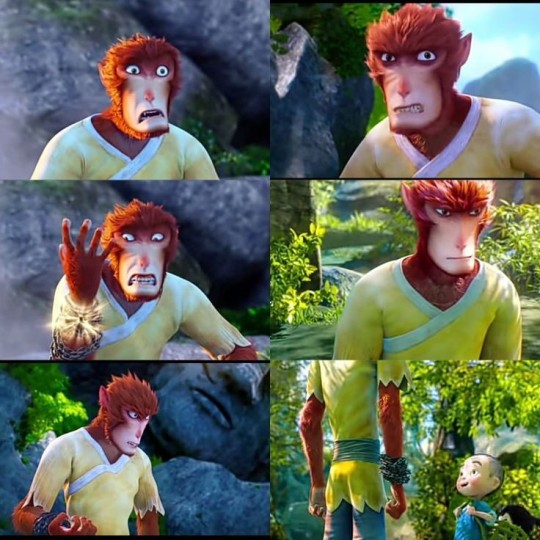
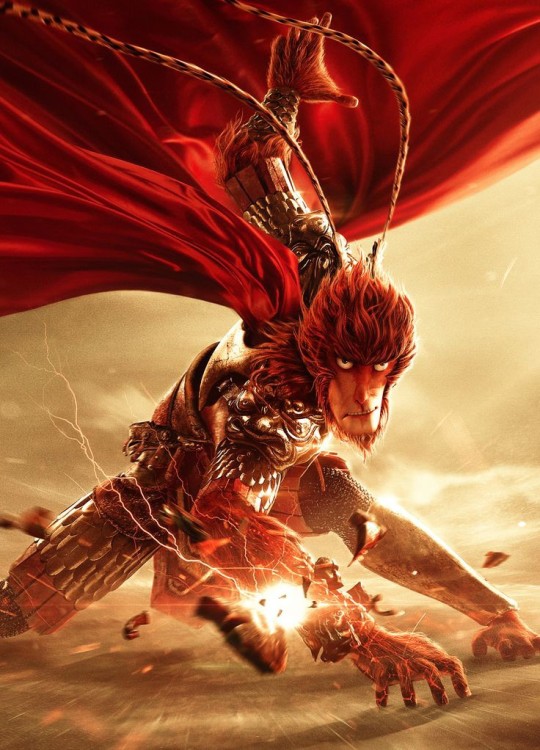
Very monkey. It's so clear and if you say that he's a monkey then I'd believe you, though I'd also doubt it. He just doesn't feel like one, or his monkey features also just doesn't sit too close to that territory. I feel like he's literally a walking Uncanny Valley amongst the other monkeys from Flower Fruit Mountain.
Some people say he could be a golden snub-nosed monkey, but SWK being based on rhesus macaques is much more convincing. He's drawn in those features in arts more, too. I know he's a stone monkey born from absorbing essence from Heaven and Earth (as well as from "nothingness" thus what Subodhi named him after) but— he doesn't belong on any existing specific genus of primates. Some wikis even only classify his "species" as "Stone Monkey, Based on rhesus macaques". Literally just "based", as in he only looks like one. A macaque-looking primate.
Also I'm not sure but isn't he also classified as a demon or Yaoguai as some sort? I don't remember well. Then, but then, I realized that in Chinese Mythology the world was created from Nothingness, too, until the giant Pan Gu cut the single line to make Yin and Yang.
"Chinese creation myths are symbolic narratives about the origins of the universe, earth, and life. In Chinese mythology, the term "cosmogonic myth" or "origin myth" is more accurate than "creation myth", since very few stories involve a creator deity or divine will. Chinese creation myths fundamentally differ from monotheistic traditions with one authorized version, such as the Judeo-Christian Genesis creation narrative: Chinese classics record numerous and contradictory origin myths. Traditionally, the world was created on Chinese New Year and the animals, people, and many deities were created during its 15 days.
In contrast to the above Chinese cosmogonic myths about the world and humans originating spontaneously without a creator (e.g., from "refined vital energy" in the Huainanzi), two later origin myths for humans involve divinities. The female Nüwa fashioned people from loess and mud (in early myths) or from procreating with her brother/husband Fuxi (in later versions). Myths about the male Pangu say that people derived from mites on his corpse. "

The Palaces of the Nine Constellations and the Eight Trigrams from the egg also corresponds to seasonal nodes (Winter Solstice, Beginning of Spring, Spring Equinox, Beginning of Summer, Summer Solstice, Beginning of Autumn, Autumn Equinox, and Beginning of Winter.) — which can mean that not only SWK was birthed from Heaven and Earth (as well as the Sun and Moon), he was also made with more yang essences than he is with yin. The Eight Trigrams may have also contributed with his immortality. You can see about the 24 solar stems of the calendar too if you're curious.
The book is chock full of body horror, too, but it happens more during the journey itself than in the beginning. SWK's immortality and healing makes it possible for him to do these things, but I have my own theory that he's not made of flesh (or anything that makes a living thing, well, living in terms of biological stuff) and that he was born from a magic stone and and is a stone monkey— his flesh/body is more like a very thick solidification of yin and yang essence, much like how the world was created in Chinese Mythology. Then perhaps balanced w the essences of the two celestial bodies, the Sun and Moon. This could contribute to how he's so hard to injure and why the Samadhi fire didn't do much damage on him, and not just because he hid closer to where the wind seal inside the crucible is.
OOF I got sidetracked a little bit but this has been sitting in my head since morning. It's just that when I look of drawings of SWK I recognize he's a monkey, but it feels like he's just something else posing as one. Like using a suit so well it blends just enough to look right. I could do more research on this but I don't have the time rn so...
But anyway— I think it's pretty cool that SWK is only based on rhesus monkeys, but not classified as one considering his origin. It's very cool and somewhat creepy and maybe even creepier for the other monkeys and animals in Flower Fruit Mountain. He's natural, but something under all that fur and skin just doesn't feel right.
Also here's a fic I've been developing as of late, if anyone's interested in reading :v
#jttw#xiyouji#journey to the west#jttw monkey king#jttw sun wukong#sun wukong#monkey king#jttw ramblings
127 notes
·
View notes
Note
So, I actually have some interesting thoughts on Wukong as a parent, specifically if you consider his species and hoa they interact with their children. While it's true he's a Stone Monkey, research indicates he's actually based in a real-life species of macaque. The resus macaque to be exact.
What does this mean for Wukong? Well, resus macaques are not only matrilinear, meaning females technically outrank the males, and the matrilinear lines exist in a ranking system, so a macaque's "rank" is depending on where their mother sits in the troop, and Wukong is the highest ranking monkey in the troop. Which brings us to his child rearing skills...
They're basically nonexistent. Or at least, they would be, if he were a normal resus macaque. Resus macaques usually tend to be hands off parents, males having absolutely no role in the raising of young and female macaques often tend to leave the responsibility of raising young to their younger and more immature daughters.
So, if MK was an unexpected child for Wukong to raise, he'd probably be panicking and look to his own troop for advice on raising a baby monkey... and see that the mothers tend to leave their offspring with their younger sisters or daughters. Wukong doesn't have anyone he can leave MK with, at least, nobody he knows as themselves...
Wukong's last real "troop" had been the Pilgrims. He is the eldest of the Pilgrims, with Zu Baije as the second eldest by virtue of being the second to join. Zu Baije has been reincarnated into a noodleshop owner down in the city where MK would likely be safe.
While the Stone Monkeys and Monkey Demons have social structures different from irl Rhesus Macaques, Wukong probably did panic and default to "give baby to troop member" when he couldnt figure out how to care for MK on his own. And his closest "troop" was the Pilgrims so...
Also the idea of him ranking Bajie as just below him cus he joined later is very in character XD
35 notes
·
View notes
Text
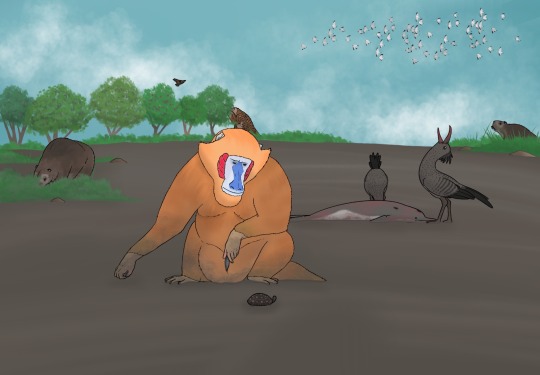
In the Anectyocene North America is one of the most biodiverse continents, thanks to the extreme variety of biomes, and having a biosphere much more different than the rest of the world. Its ten million years isolation from Afro-Eurasia, and partial isolation from South America, thanks to both mountains and the rainforest not allowing bigger pampas and chaco dwellers to reach the northern continent, allowed it to develop much more distinct ecosystems.
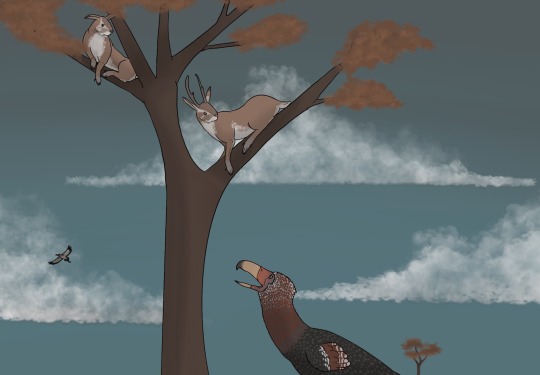
One of the most diverse and common clades in the continent are Lepolopidae, walking or running jackrabbits inhabiting both the grasslands, the redwood forests in the west and the humid forests in the east, that diverge in many ways from their Eurasian cousins.
They’ve developed antlers instead of tusks (or horns in some cases), and evolved their outermost toes into opposable and semi-opposable digits, allowing them to become quite skilled climbers, letting them browse on trees regardless of their height, and helping them escape from land dwelling predators.
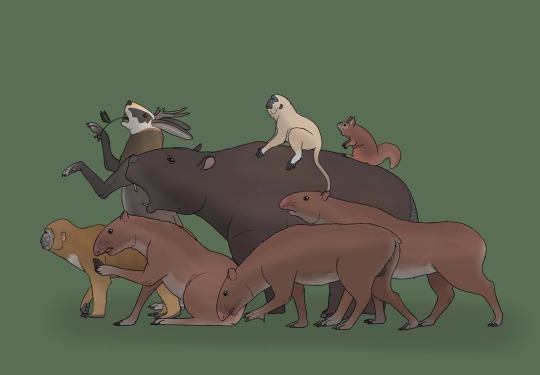
Another quite diverse group of herbivores are the Mayarrhinidae, agouti descendants that came from Central America and expanded into the rest of the continent, that consume almost every kind of plant matter and are quite important seed dispersers of evergreens and oak-trees.
The most important seed dispersers of the continent, tho, are monkeys, especially macaques, whose expansion northwards allowed the expansion of many plants descended from feral fruit producing species.
North American monkeys are all descended from four ancestral introduced species: squirrel monkeys, capuchins, crab eating macaques and rhesus macaques. The first two are for the most part limited to Florida, and on a lesser degree the denser parts of the southern US’ forests, while the two macaques have an almost continent-wide range, going from British Columbia to Sinaloa, and from California to Newfoundland. Thanks to the absence of primates in these areas these macaques have been able to undergo an adaptive radiation, giving life to the polyphyletic group of the New World macaques (Bibliopithecinae, for the rhesus descendants, and Galactopithecinae, for the crab-eater descendants), and resulting in a myriad of forms resembling baboons, geladas, tamarins (that in some cases even compete with squirrels) and apes.
Many changed diets, becoming grazers, leaf eaters and in one case molluscivorous. The Cyonuropithecus caelurorrhinus is a Galactopithecine part of a gelada like genus inhabiting the areas of the Atlantic coast of Canada and the Northern US. Although the other members of its genus are for the most part grazers their diet is mainly made up of molluscs and crabs that they found on the shore with low tide. For this lifestyle they evolved naked hands and wrists and a stronger bite force. They’re also some of the best primate swimmers, thanks to their partially webbed hands.
Some of the biggest herbivores of the continent evolved from beavers, the biggest surviving rodents, that would become as big as hippos and rhinos, and would graze on the bushes and grasses on the ground. The actual biggest land animals, tho, are the ground porcupines, that came from South America, and being generally good rainforest dwellers were able to pass through Central America with ease.
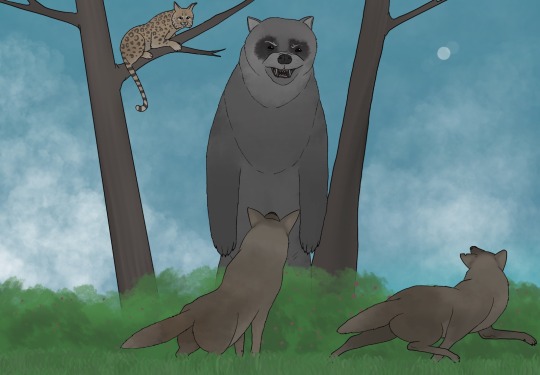
The predators of North America, though, are what really set it apart from the rest of the world, being the only continent, not counting islands like Madagascar, without a mammalian apex predators. Like South America during most of the Cenozoic the continent’s hypercarnivores are birds, more specifically caracara descendants, whose only competitors are the Diacyonines, bear-like raccoon descendants with an omnivorous diet. The other main predatory clades of the continent are the Latrantocyonines, wolf analogues descended from coyotes, and partially from dogs too, the Lycornithines, roadrunners that mainly scavenge and hunt small game, and Bizofelines, descendants of domestic cats that are now arboreal lynx like hunters, and effective mountain dwellers too.
https://discord.gg/KjusGndh discord link if u wanna join the project’s server
#spec evo#spec bio#speculative evolution#speculative biology#artwork#worldbuilding#digital art#epigene period#future earth
18 notes
·
View notes
Text
Yuze (FFM demon monkey OC)
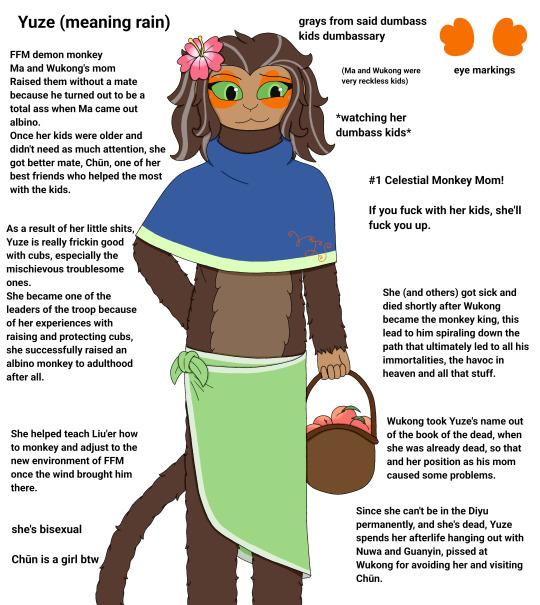
Yuze is Ma and Wukong's mom! She's going to be in the next chapter and she's kinda important overall because she's Wukong's mom and hangs out with Nuwa so she'll be there when that meeting happens.
Her favorite kinds of fruits are sun dried fruits, other than that she doesn't really have a specific favorite. She enjoys her kids bickering over what's better, peaches or raspberries. She does have a least favorite and that's bananas.
This is her when Wukong and Ma were younger, around the time the wind brought Liu'er to FFM. She looks different by the time she died, more grays, but otherwise the same.
She still called Wukong "Shí Hóu" when he became the monkey king and after he got the name Sun Wukong, it's more of an affectionate nickname than anything else, and it gets the response of saying a full name when she's mad. She also called him Táo huā, peach blossom, cause when she first met him, he kept trying to eat peach flowers.
Nuwa and Yuze's relationship is very fun to play with because Nuwa did not know about Wukong until well after he was hatched and being raised by Yuze, so she thought he didn't need her, how wrong she was, she eventually got her act together (after much verbal smack from Yuze and the Wind).
Wukong and Nuwa have a rough, complicated relationship, but it's better than it has been.
I also thought I'd go over the differences between demon monkeys and celestial/stone monkey so and some other stuff about demon monkeys.
It's a little long so I put it under the cut.
Shadowpeach Family AU Masterpost
First difference is the face markings, demon monkeys don't have full face masks like celestial/stone monkeys do, they just have markings around their eyes.
The shape of markings indicate where they are from, FFM monkeys have more flower shaped markings. Color can also help but the shape is more important to location.
Demon monkeys are also much shorter than celestial monkeys. 4'5" to 5' is the general height range, rarely do they get to 5'1". Wukong is 5'1", Macaque is 5'4", cause short king Wukong is funny.
Demon monkeys, like rhesus macaques, are matriarchal. They highly value good parenting and being able to protect and provide for the troop, cubs especially.
Most of the leaders of the FFM troop (and demon monkey troops in general) are demon monkeys with a lot of experience raising and/or protect their troop, cause they're matriarchal most of them are female presenting. Demon monkeys don't care what you present your gender as, they just care if you help the troop.
Wukong finding a safe, secure shelter for the troop to live in and retreat to if there's trouble and his ability to protect the troop really well, he became the Monkey King even though he's male presenting (he's trans🏳️⚧️) and mentally a young teenager at the time is because he's so good at protecting and providing for the troop, and most of the decisions he makes are made with the in put from the other demon monkey leaders.most of them, he didn't consult them for any of his havoc in heavy or brotherhood nonsense, most of the demon monkeys stayed away from the brotherhood.
Demon monkeys generally wear looser clothing that only really covers their more private parts, they don't need to wear much more because of their fur, the main exception is Ma and Xuěhuā because they are albino and need more protection from the sun.
Thanks for reading this if you came this far!
#lego monkie kid#lmk fanart#lmk sun wukong#lmk macaque#lmk six eared macaque#lmk oc#Flower Fruit Mountain#Monkey demons#lmk oc art#lmk ocs#Shí Hóu#lmk art#lmk au art#lmk au#lmk aus#Yuze#marshal ma#Lmk Marshal Ma#shadowpeach au#Shadowpeach Family AU#VJS Art:P#VJS AU:P#VJS OCs:P#VJS
14 notes
·
View notes
Note
hi! could i have a moodboard of a rhesus macaque (if you’d like a specific picture, the “wet beast wednesday” one on my blog lol), with a sunset, fruit, & water based aesthetic? thank you! i’ll def. request more your moodboards are (mwah)! — @empathyhearts
Hello!! I'm glad you enjoy my moodboards, here's yours!
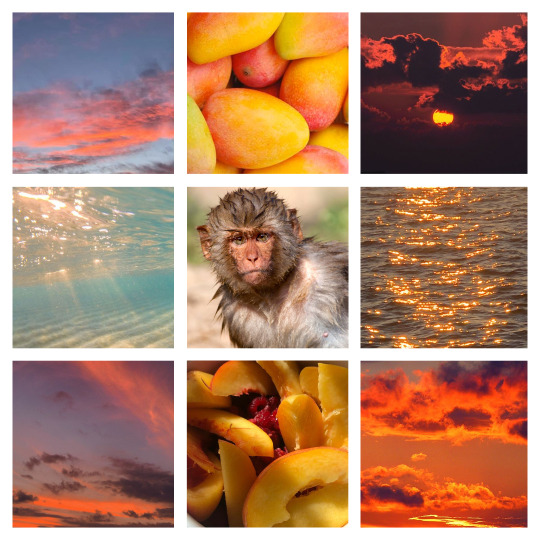
Requests are open!
#bingo shut up#bingos images#otherkin#otherkin community#otherkin moodboard#therian community#therian#therian moodboard#monkeykin#monkey therian
18 notes
·
View notes
Text
Interesting Papers for Week 25, 2024
Silencing CA1 pyramidal cells output reveals the role of feedback inhibition in hippocampal oscillations. Adaikkan, C., Joseph, J., Foustoukos, G., Wang, J., Polygalov, D., Boehringer, R., … McHugh, T. J. (2024). Nature Communications, 15, 2190.
A multi-demand operating system underlying diverse cognitive tasks. Cai, W., Taghia, J., & Menon, V. (2024). Nature Communications, 15, 2185.
A view-based decision mechanism for rewards in the primate amygdala. Grabenhorst, F., Ponce-Alvarez, A., Battaglia-Mayer, A., Deco, G., & Schultz, W. (2023). Neuron, 111(23), 3871-3884.e14.
Local and global predictors of synapse elimination during motor learning. Hedrick, N. G., Wright, W. J., & Komiyama, T. (2024). Science Advances, 10(11).
Laminar evoked responses in mouse somatosensory cortex suggest a special role for deep layers in cortical complexity. Hönigsperger, C., Storm, J. F., & Arena, A. (2024). European Journal of Neuroscience, 59(5), 752–770.
Synaptic wiring motifs in posterior parietal cortex support decision-making. Kuan, A. T., Bondanelli, G., Driscoll, L. N., Han, J., Kim, M., Hildebrand, D. G. C., … Lee, W.-C. A. (2024). Nature, 627(8003), 367–373.
Organization of reward and movement signals in the basal ganglia and cerebellum. Larry, N., Zur, G., & Joshua, M. (2024). Nature Communications, 15, 2119.
Autokinesis Reveals a Threshold for Perception of Visual Motion. Liu, Y., Tian, J., Martin-Gomez, A., Arshad, Q., Armand, M., & Kheradmand, A. (2024). Neuroscience, 543, 101–107.
Temporally organized representations of reward and risk in the human brain. Man, V., Cockburn, J., Flouty, O., Gander, P. E., Sawada, M., Kovach, C. K., … O’Doherty, J. P. (2024). Nature Communications, 15, 2162.
Neural timescales reflect behavioral demands in freely moving rhesus macaques. Manea, A. M. G., Maisson, D. J.-N., Voloh, B., Zilverstand, A., Hayden, B., & Zimmermann, J. (2024). Nature Communications, 15, 2151.
Changes in spatial self-consciousness elicit grid cell–like representation in the entorhinal cortex. Moon, H.-J., Albert, L., De Falco, E., Tasu, C., Gauthier, B., Park, H.-D., & Blanke, O. (2024). Proceedings of the National Academy of Sciences, 121(12), e2315758121.
Goal-seeking compresses neural codes for space in the human hippocampus and orbitofrontal cortex. Muhle-Karbe, P. S., Sheahan, H., Pezzulo, G., Spiers, H. J., Chien, S., Schuck, N. W., & Summerfield, C. (2023). Neuron, 111(23), 3885-3899.e6.
A persistent prefrontal reference frame across time and task rules. Muysers, H., Chen, H.-L., Hahn, J., Folschweiller, S., Sigurdsson, T., Sauer, J.-F., & Bartos, M. (2024). Nature Communications, 15, 2115.
Interactions between circuit architecture and plasticity in a closed-loop cerebellar system. Payne, H. L., Raymond, J. L., & Goldman, M. S. (2024). eLife, 13, e84770.
Functionally refined encoding of threat memory by distinct populations of basal forebrain cholinergic projection neurons. Rajebhosale, P., Ananth, M. R., Kim, R., Crouse, R., Jiang, L., López-Hernández, G., … Talmage, D. A. (2024). eLife, 13, e86581.
Functional architecture of dopamine neurons driving fear extinction learning. Salinas-Hernández, X. I., Zafiri, D., Sigurdsson, T., & Duvarci, S. (2023). Neuron, 111(23), 3854-3870.e5.
Neural attentional filters and behavioural outcome follow independent individual trajectories over the adult lifespan. Tune, S., & Obleser, J. (2024). eLife, 12, e92079.3.
Coordinated head direction representations in mouse anterodorsal thalamic nucleus and retrosplenial cortex. van der Goes, M.-S. H., Voigts, J., Newman, J. P., Toloza, E. H., Brown, N. J., Murugan, P., & Harnett, M. T. (2024). eLife, 13, e82952.
Specific rules for time and space of multisensory plasticity in the superior colliculus. Wang, L., Xin, H., Buren, Q., Zhang, Y., Han, Y., Ouyang, B., … Dong, C. (2024). Brain Research, 1828, 148774.
Structural constraints on the emergence of oscillations in multi-population neural networks. Zang, J., Liu, S., Helson, P., & Kumar, A. (2024). eLife, 12, e88777.3.
#neuroscience#science#research#brain science#scientific publications#cognitive science#neurobiology#cognition#psychophysics#neurons#neural computation#neural networks#computational neuroscience
6 notes
·
View notes
Text
Innovative molecular biology technique allows for discovery of novel targets for candidate vaccines against schistosomiasis
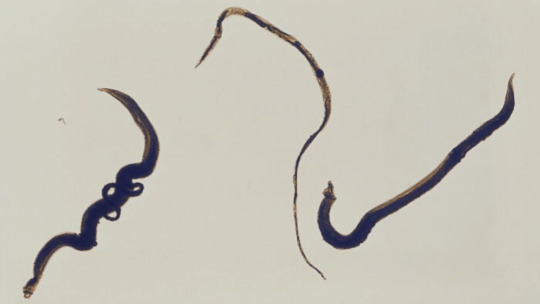
- By Luciana Constantino , Agência FAPESP -
Researchers in Brazil have used an innovative technique in molecular biology to identify targets for candidate vaccines against Schistosoma mansoni, the parasite that causes schistosomiasis.
Considered one of the world’s 17 neglected tropical diseases (NTDs), schistosomiasis affects some 200 million people in 74 countries, according to the World Health Organization (WHO). Six million are estimated to be infected in Brazil, mainly in the Northeast region and Minas Gerais state.
The scientists used phage display, the study of protein interactions using bacteriophages, viruses that infect bacteria, to screen 99.6% of 119,747 DNA sequences encoding the proteins known to be expressed across all life-cycle stages of the parasite, achieving comprehensive coverage of its proteome.
The results of the study are reported in an article in NPJ Vaccines, an open-access journal published by the Springer Nature group.
They follow on from those of a previous study that revealed the mechanism whereby the Rhesus macaque Macaca mulatta naturally develops a lasting immune response against schistosomiasis by inhibiting certain of the parasite’s genes so that it cannot multiply in the host organism. This immune response leads to self-cure after first contact with S. mansoni and enables the animal to react faster to a second infection (read more at: agencia.fapesp.br/37688).
“Phage display had never been deployed for this purpose in research on parasitic diseases, which normally involves preselection of a few targets for testing of candidate vaccines. In this study, we screened 12,000 proteins of S. mansoni at the same time to identify which ones were targeted by the macaque’s antibodies, both after initial infection and reinfection and after reinfection and self-cure, a key innovation. Both the technique and the model for the study were innovative,” said Murilo Sena Amaral, a researcher at Butantan Institute’s Laboratory of Cell Cycle.
Amaral is the penultimate author of the article. The last author, as principal investigator for the study, is Sergio Verjovski-Almeida, also a researcher at Butantan Institute and a professor at the University of São Paulo’s Institute of Chemistry (IQ-USP).
Both are supported by FAPESP (15/06366-2 and 20/01917-9), which has also funded scholarships for other researchers in the group (18/18117-5, 19/02305-0 and 16/10046-6), including a PhD scholarship for first author Daisy Woellner Santos.
Methodology
The researchers investigated the immune response of ten macaques infected by S. mansoni during the stages of self-cure and resistance to reinfection using a recently developed technique called peptide library-based phage immunoprecipitation sequencing (PhIP-Seq). They constructed a phage display library that comprised 119,747 DNA sequences encoding 11,641 known proteins from S. mansoni in all stages of its life cycle. The library was incubated with antibodies collected from rhesus macaques in a previous study at different points during the process of self-cure and resistance to reinfection. The aim was to isolate and identify specific targets of the animal’s immune response to the parasite.

The study involved rhesus macaques, which naturally develop a lasting immune response to the disease (photo: researcher’s archive)
Library screening with antibodies from the early phase of parasite infection identified significantly enriched epitopes of parasite extracellular proteins known to be expressed in the host’s digestive tract, shifting toward intracellular proteins during the late phase of parasite clearance (released owing to its death). Epitope refers to the specific target against which an individual antibody binds. When an antibody binds to a protein, it bonds not to the entire protein but to a segment known as an epitope.
The enriched peptides were analyzed with bioinformatics tools to identify potential candidates for vaccines. The most promising candidates were tested in a pilot vaccination assay, in which mice were immunized with a selected pool of PhIP-Seq-enriched phage-displayed peptides. The result was a significant reduction of worm burden in the immunized mice.
“You often hear the argument that a schistosomiasis vaccine isn’t feasible, but our discoveries have revealed a great deal of the immune response and opened up promising prospects for the development of an effective vaccine. We worked with the 12,000 proteins key to all stages of the parasite’s life cycle and succeeded in identifying the most reactive targets,” Verjovski-Almeida told Agência FAPESP. The technique can be used for other types of parasite, he added.
In an article published in May 2023, the group described their discovery of a way to “separate” male and female parasites so as to prevent reproduction and egg release. Male-female pairing, with the female living inside the male, is essential to their survival. Without it, they die. In the study, the researchers showed that male-female separation could be obtained by silencing specific long noncoding RNAs (lncRNAs), which are therefore a promising target for treatment of the disease (read more at: agencia.fapesp.br/41908).
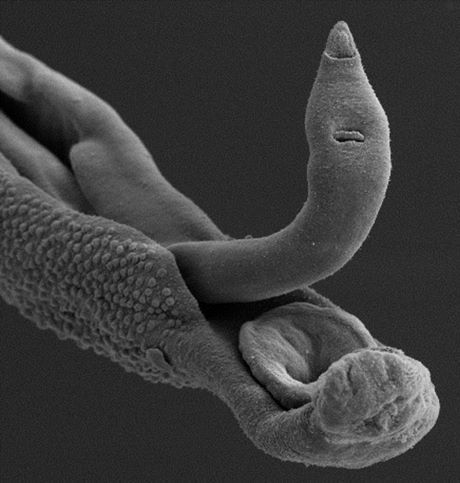
Female inside male of Schistosoma mansoni (photo: researcher’s archive)
How the worm works
Schistosomiasis is a parasitic disease associated with poor hygiene and a lack of basic sanitation. It is transmitted when an infected person excretes feces containing schistosome eggs into the environment. The eggs hatch in freshwater, releasing larvae that infect snails. The snails are intermediate hosts, while humans are definitive hosts.
After four weeks, the larvae leave the snail as cercariae, the free-swimming larval stage. When humans come into contact with contaminated water, they acquire the disease via active skin penetration by cercariae.
In the human bloodstream, the cercariae progress to the schistosomule stage, eventually becoming adult worms that lodge in the veins of the intestines. The first symptoms of the disease appear two to six weeks after infection.
The disease is diagnosed by laboratory analysis of feces. Simple cases can be treated by a single dose of praziquantel, a drug discovered in the 1970s and distributed in Brazil by the national health system (Sistema Único de Saúde, SUS). However, it does not assure continuous protection. Patients taking it can be reinfected, and there are reports of parasite drug resistance.
“The next step is to develop a suitable vaccine formulation containing adjuvants and a novel mechanism for delivery of these antigens so that they produce better protection in the host. We have some targets with higher response levels,” Verjovski-Amaral explained. Butantan Institute has applied for a patent on the group’s discoveries linked to possible vaccine targets.
Oswaldo Cruz Foundation (FIOCRUZ), an arm of the Brazilian Health Ministry, has been working for years on what could be the world’s first schistosomiasis vaccine. Called Schistovac, it is in the testing stage and contains a modified version of the Sm14 protein found in S. mansoni. The protein normally plays a key role in trafficking fatty acids, which are essential to the parasite’s cellular functions. The modified version is designed to prevent proliferation.
The article “Schistosoma mansoni vaccine candidates identified by unbiased phage display screening in self-cured rhesus macaques” is at: www.nature.com/articles/s41541-023-00803-x.
This text was originally published by FAPESP Agency according to Creative Commons license CC-BY-NC-ND. Read the original here.
--
Header image: This micrograph reveals four Schistosoma mansoni trematodes, a pair (left), a female (center), and a male (right). Credit: CDC/Wikimedia Commons. Ed note: A slight blue filter has been applied.
Read Also
Test detects co-infection by novel species of parasite in severe cases of visceral leishmaniasis
2 notes
·
View notes
Text
What do you do when an episode hits?
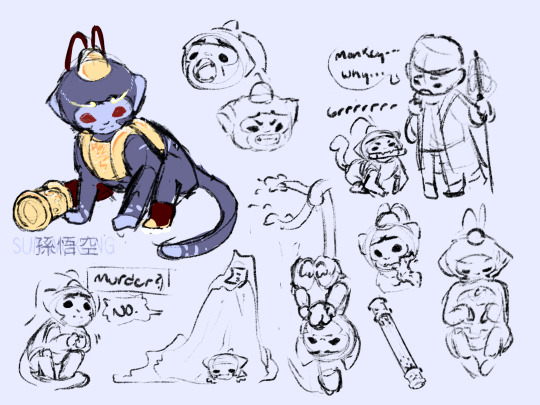
Make a lil guy!
Here’s my personal idea of Sun Wukong! The design is almost 100% subject to change as I dig up for details on his description and mess around with colours, but for now, monke.
Small thingies:
- His appearance is a loose mix between a rhesus macaque (which he is highly theorized to appear as) and a baby langur (because blorboification)
- I’m taking “Intelligent Stone Monkey” seriously here; he is a stoney boy
- He’s specifically a geode, meaning that being broken reveals rubies and gold underneath! (“What about those scenes that vividly describe his blood and organs?” Uhhh illusion magic/72 transformations next question)
- He is still a short kingtm
- The cloud-walking boots are fluffy because I say so
As said before, this is my personal interpretation of his appearance within the novel. If you have a different idea, that’s neat! I’d love to compare murderous fellas. Unless I’m genuinely portraying him harmfully, let’s all just have a good ole time :]
#journey to the west#jttw#jttw sun wukong#xiyouji#monkey king#sun wukong#great sage equal to heaven#character design#lego monkie kid#monkie kid#lmk#tagging lmk cause I think the lego fans will also appreciate this#art!#post!#making mystic monkeys
325 notes
·
View notes
Text
Blog 1: First of Many
Hello! My name is Pratik, and I am a 5th-year Zoology Major and Plant Science Minor. This is the first of hopefully many blog posts that I will be writing weekly for at least the next 3 months.
My current relationship with Nature is deeply rooted in my heritage and culture. I was born in Nepal where I spent the first 12 years of my life before immigrating to Canada with my family. Nepal is a country that focuses on agriculture and tourism and houses the tallest Mountain on Earth, Mt. Everest. Most of the people I knew grew up as farmers and villagers who deeply cared about their land and natural resources. This allowed me to grow up intertwined with nature where I both respected and feared the jungles of Nepal as they are home to Bengal tigers, Indochinese rhesus macaques, leopards, wild boars, and the Big Four snakes.

Kathmandu, Nepal where I grew up.
When I first started exploring the parks and conservation areas of Canada, I found it interesting how visitors did not fear the wildlife. This baffled me at first as I assumed Grizzly bears, cougars, and wolves roamed most of Canada and frequently clashed with the local populations like in Nepal. After doing some more research, I realized that none of the 3 animals roamed the parks near my place, and I, too, had nothing to fear like the local visitors. After 10 years in Canada, my fear of nature has eroded away, and nowadays, I frequently find myself exploring off-the-path trails and making my own path when exploring Nature. However, my respect for Nature persists as Nature, when disrespected, can be very unforgiving based on the countless tales I have heard from park naturalists, guides, and locals.
As it stands now, my relationship with Nature is built on respect and a tiny bit of fear where I plan to center my future career around Nature and Academia, hoping to make them more accessible to the public.
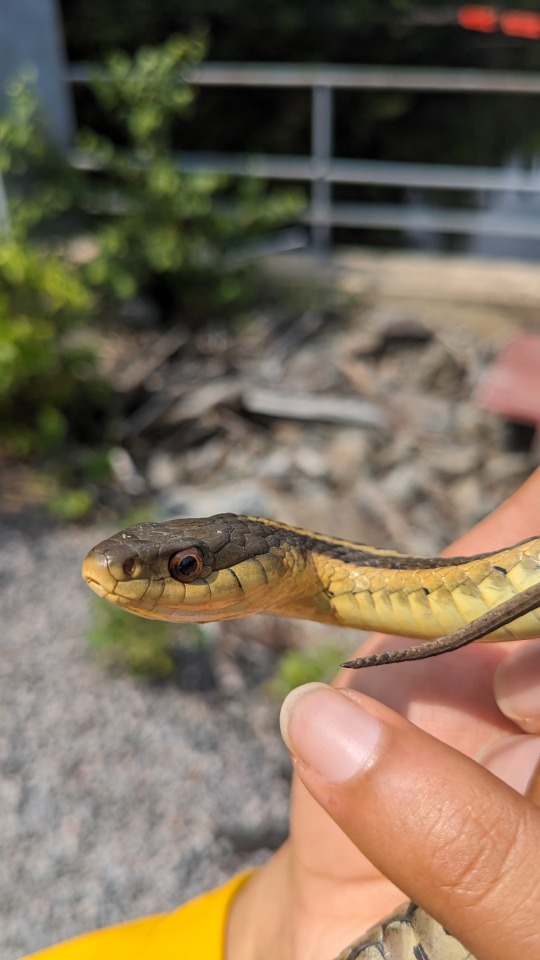
Holding a Garter Snake for my Field Course Paper in Algonquin Park
The two people that offered me a sense of place in Nature were Steve Irwin and Jeremy Wade. Steve Irwin was my introduction to wildlife outside of Nepal, and he taught me that wild animals, specifically snakes, are not evil by nature. They are, instead, misunderstood due to their appearance, causing humans to cull them from their local range. In Ontario, the Timber Rattlesnake was extirpated by hunters due to the snake being venomous even though conflicts were rarer than perceived. Steve Irwin showed me that wildlife does not like to be bothered, and their actions against humans are often justified (hunger, young protection, habitat loss).
Jeremy Wade was a professional angler who hosted the TV show known as River Monsters. He traveled the world, searching for freshwater-inhabiting creatures mentioned in local folklore. I remember vividly that his show was one of the first to showcase Nepal outside of the Himalayas. He showed me that the local population is more than often the most educated regarding wildlife inhabiting their lands. Jeremy would always listen to the stories of the local population and explore any leads they provided no matter how fictional they sounded. He taught me that working with the local population is the best way of studying Nature in a new environment and their opinions should not be ignored.

Remic Rapids Park, Oattawa
3 notes
·
View notes
Note
I thought wukong was a macaque too? Rhesus macaque to be specific.
thats the kind hes based off of and looks like yeah but since hes a stone celestial monkey wouldnt he be considered a different species as a whole like the six eared macaque is ??
at this point anon take alot of what i say with a grain of salt i have the worst memory known to man and like 50 different illnesses /j
#🏮#shadow talks#i havent finished jttw so jttw related stuff im not too...knowledgeable on#its why i mostly talk about lmk as thats. my special interest#but also take note i am stupidTM and have memory issues so#i mix things up alot sorry
2 notes
·
View notes
Text
TOP 4 MONKEYS IN SPACE
#4: Albert (all 6 of them.) A group of unfortunate (but record breaking Rhesus Macaques. Albert 1 was the first monkey ever launched by a rocket, though there's a chance that the American army actually just launched his corpse because he died in the capsule. Albert 2 was the first monkey to specifically enter outer space (before him, only fruit flies were sent to space) and died from a parachute failure. Mention also goes to Albert 3 (exploded,) Albert 4 (parachute failure,) and Albert 5 (yet another parachute failure.) Albert 6 somehow survived the landing, but was accidentally baked in the New Mexico heat before he could be retrieved.

#3: This one goes to my boy HAM. First great ape in space, he managed to operate his capsule while having a 16cm thermometer shoved up his ass, and all he got was some fruit and a premature death at 21 years after the mission. He would've been higher on this list, of not for...

#2: Enos, Ham's unlucky successor. This poor little guy had to endure 76 shocks after his equipment for "avoidance conditioning" malfunctioned, before being stranded and so stressed out that he ripped off some of his medical devices. The only chimp to orbit the earth, he got the short end of the stick multiple times; tales of his grouchy disposition eventually mutated into rumors of a chronic... public indecency habit, and he died at just 5 years old from dysentery.

#1: Miss Baker. This one-pound diva was bought in a Miami pet store and became the first animal the US launched into space that returned safely, alongside her partner, Miss Able (who died during post-mission surgery.) She had officiated monkey weddings, medals, honors, and birthday parties thrown with varying amounts of cottage cheese and strawberry jello (her favorite) before dying at 27 as the oldest-lived squirrel monkey.

These are all American flights, for two reasons- A, there is less info on the Soviet monkeys, which were named alphabetically and tended to fare much better, and B, they preferred using dogs (RIP Laika!) Still, the # 6-11 of the Bion satellite missons in the 80s and 90s took with them two monkeys each, until a single post-surgery death caused the whole monkey business to stop. One of them even met Castro.
#space race#space exploration#history#NASA#space travel#animal experimentation#animal death#ussr#soviet union
1 note
·
View note
Text
I know Sun Wukong is specifically a rhesus macaque but it would rule if he was a Japanese macaque. Sun Wukong chilling in hot springs etc
#believe it or not I got halfway through this post before I noticed the problem with Sun Wukong being a JAPANESE macaque#I usually call them snow monkeys in my head so I wasn’t really thinking about the fact that they aren’t found in China
1 note
·
View note